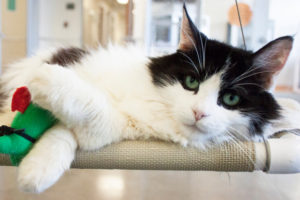
Pet of the week: Cookie is a 6-year-old female domestic long-hair cat with the softest black and white fur and bright green eyes. She’s a confident and outgoing gal who loves to play. This affectionate kitty is looking for a new home. She has lived with other cats in the past. Ask for Cookie, ID# A824291.
Adoptable pets are available at Peninsula Humane Society & SPCA’s Tom and Annette Lantos Center for Compassion, 1450 Rollins Road, Burlingame. For information, call 650-340-7022 or visit www.phs-spca.org. (Thelma Andree / Peninsula Humane Society)
Dear Miss Behavin’: My Great Dane mix pulls like crazy on leash. How can I save my arm and get him to walk nicely?
Reply: For dogs that are very large or strong, often the best investment is a high-quality harness or head collar that is designed to help curb pulling. Most dogs do not mind wearing a body harness, so that’s usually the best tool to try first. In addition, a harness will put less pressure on your dog’s neck than a collar, which will be better for his health in the long-term. Your dog should still also wear a collar on at all times even at home (with current tags attached), in addition to having a microchip implant for identification.
When choosing a harness, avoid one where the leash attaches to the back of a dog. These harnesses can work fine for small dogs, but not larger ones. Think of a sled dog. Where does the sled attach? It attaches to the back of the dog. If you put this type of harness on your Great Dane, you’re essentially inviting him to treat you like a sled.
To help reduce pulling, the best type of harness is a front-lead harness, meaning the leash attaches to your dog’s chest. This may seem awkward at first, but when your dog pulls, the harness will actually guide his body back toward you. We sell these front-lead harnesses at our Furchandise store, at 1450 Rollins Road in Burlingame, and our knowledgeable staff can assist with properly fitting it on your dog.
If you have a dog that still pulls with a front-lead harness, is exceptionally strong, or lunges and barks at other dogs on leash, you may need to upgrade to a head halter. Just like with a horse, a head halter goes over your dog’s head to give you complete control. Your dog can still pant, drink and eat while wearing it. Unlike with a harness, which dogs generally accept without fuss, a head halter takes some getting used to. You will need to invest the time training him to wear one.
